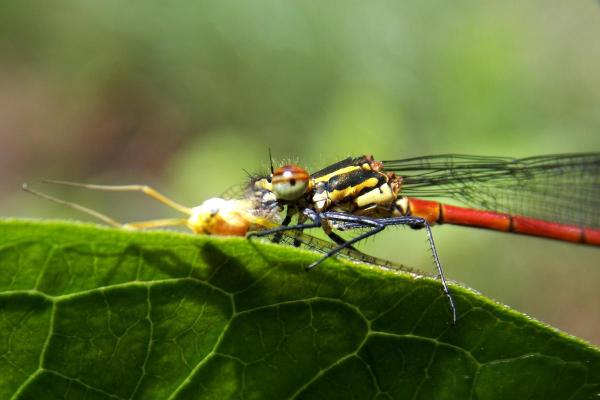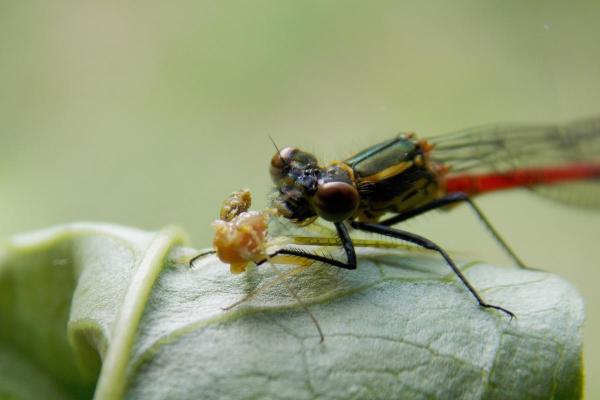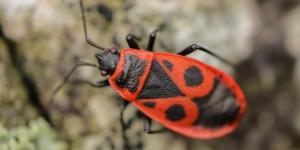Do Dragonflies Bite or Sting?


Many people give dragonflies a wide berth, fearing their impressive size and those giant, watchful eyes. These ancient insects, dating back millions of years, are renowned for their agility in the air and their important role in controlling insect populations. However, for many, their shimmering wings and lightning-fast movements, can seem a bit intimidating. But is this fear justified?
In this AnimalWised article, we'll explore the question of whether dragonflies bite or sting, dispel the myth of their danger, and delve into the fascinating facts about these insects.
What are the body parts of a dragonfly?
There are over 5,000 known species of dragonflies worldwide! Most live in tropical regions, with fewer found in temperate areas. This huge variety means there are dragonflies in all shapes and sizes, with amazing color variations. However, what they all have in common, is that their bodies are perfectly designed for both speed and hunting. While adult dragonflies are primarily mosquito hunters, their diet is quite varied. They'll snatch up flies, gnats, midges, and even other smaller dragonflies.
Their wingspan can range from a few centimeters to over a foot, depending on the species, and these wings enable dragonflies to maneuver swiftly and gracefully through the air, making them effective hunters. Like most insects, dragonflies have six jointed legs attached to their thorax. These legs are specialized for grasping prey and perching on various surfaces. Another interesting feature is the dragonfly's ability to lock its head in place while feeding or flying. This is achieved through a system of specialized muscles.
Dragonflies are flying predators, and their mouthparts are built to catch and eat prey. Unlike some insects with biting or chewing mouthparts, dragonflies have extra-strong mandibles. These act like powerful jaws, perfect for grabbing and crushing their prey.
Adult dragonflies have a special tool called a labium. This lower lip is modified into a grabbing machine called a labrum. This labrum forms a long, hollow tube that adult dragonflies use to snatch and hold their prey steady while they eat. With both powerful jaws and a grabbing tool, dragonflies are well-equipped hunters of the skies.
Even more impressive, dragonfly nymphs (young dragonflies) use these mandibles underwater! The mandibles even have serrated edges, like a tiny saw, to help nymphs grasp and crush their prey, which is mostly other aquatic insects and small fish.
Do dragonflies sting or bite?
The answer is a resounding no. Unlike bees, wasps, and hornets, dragonflies lack the specialized organ used for stinging – a barbed stinger connected to a venom sac. This stinger injects venom that can cause pain, swelling, and allergic reactions in humans. Dragonflies simply don't have this equipment.
Dragonflies are fierce predators, using their powerful jaws (mandibles) to capture and devour their prey. They might try to bite if cornered or held, but these bites are typically weak. Their mandibles are designed for grasping and tearing prey, not piercing thick human skin.
They may exhibit defensive behavior if they feel threatened or trapped. Dragonflies might buzz their wings rapidly, creating a sound to startle potential threats. They may swoop close to a perceived danger, like a human reaching out to touch them. This is meant to deter the threat, not attack.
These defensive actions are a way for dragonflies to scare away potential predators, not harm humans. Dragonflies are more interested in catching mosquitoes, flies, and other small insects for food than bothering people.
Can dragonflies be poisonous?
Dragonflies use their six legs for perching, grasping, and maneuvering during flight. These legs are not equipped for stinging or injecting any harmful substances. Similarly, the ovipositor in female dragonflies is used for laying eggs in water or plant tissue. While it can pierce soft surfaces, it's not strong enough or designed to sting humans.
Unlike some stinging insects, dragonflies don't produce venom. They rely on their sharp mandibles to subdue and eat their prey. This means there's no risk of encountering a venomous bite or allergic reaction from a dragonfly.
Fascinated by dragonflies? Discover another incredible insect, their close relative with a unique appearance and behavior, in our next article.

How to remove a dragonfly from a room
If you find a dragonfly in your house, there's no need to panic. Here are some simple steps to help it find its way back outside:
- The easiest approach is to simply open a window wide enough for the dragonfly to fly out. If there's a screen, make sure it's open as well. Most likely, the dragonfly flew in by accident and will be happy to find its way back outdoors.
- If the dragonfly seems hesitant to leave on its own, you can gently guide it towards the open window.
- Don't make any sudden movements that might startle the dragonfly. Let it land on a window sill, plant, or other surface.
- Once it's settled, carefully place a thin piece of paper or a leaf near it. The dragonfly might crawl onto the object, allowing you to carry it closer to the open window.
- If the dragonfly is perched and seems calm, you can simply leave the room with the window open. It will likely find its way out eventually.
It is important to avoid swatting or grabbing, since this will stress the dragonfly and could potentially injure it.
Remember, dragonflies are fascinating creatures that pose no real threat to humans. They are beneficial insects that help control mosquito populations. Their primary focus is on hunting prey and avoiding danger. So the next time you encounter a dragonfly, relax and enjoy observing these beneficial insects.
Curious about other insects with a reputation for stinging? Our next article explores the world of wasps and their role as both pollinators and potential stingers.

If you want to read similar articles to Do Dragonflies Bite or Sting?, we recommend you visit our Facts about the animal kingdom category.
- Miner, A. (2014). "Anax junius" . Animal Diversity Web. Available at: https://animaldiversity.org/accounts/Anax_junius/
- Ramirez, Alonso. (2010). Chapter 5: Odonata . Journal of Tropical Biology, 58 (Suppl. 4), 97-136. Retrieved May 13, 2024, from http://www.scielo.sa.cr/scielo.php?script=sci_arttext&pid=S0034-77442010000800005&lng=en&tlng=es.
- Torralba, A. (2015). Order Odonata . Available at: http://sea-entomologia.org/IDE@/revista_41.pdf







